MARIANI’S
Virtual
Gourmet
September 18,
2016
NEWSLETTER
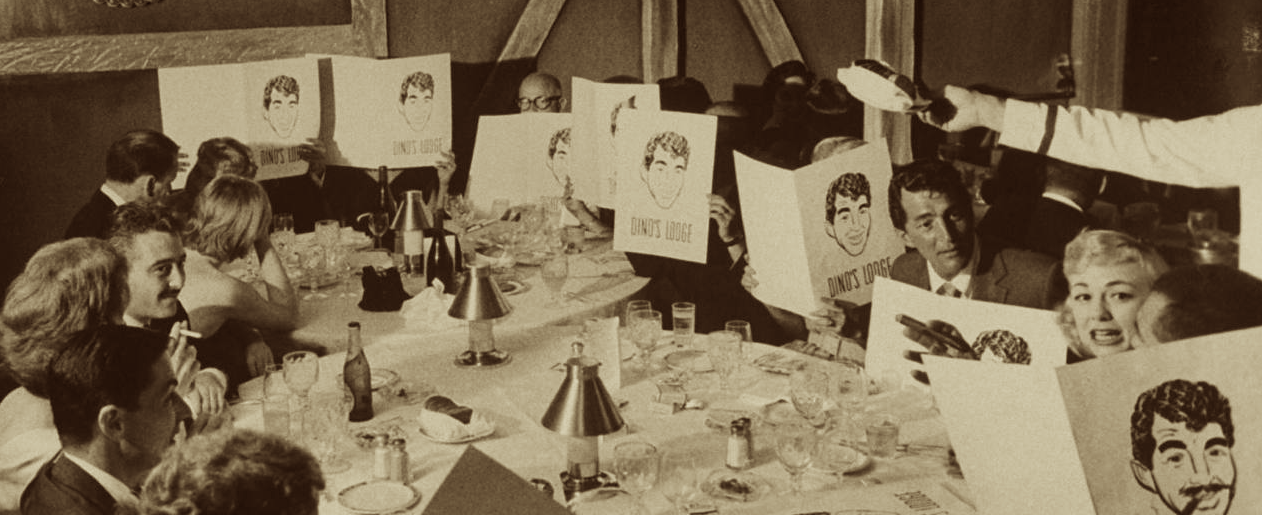
(Note sketched-in caricature of comedian Ernie Kovacs, with cigar, on the far right menu with his with Edie Adams to the left)
❖❖❖
IN THIS ISSUE
KOHLER, WISCONSIN
By John Mariani
NEW YORK CORNER
LE COU COU
By John Mariani
NOTES FROM THE WINE CELLAR
MAISON DROUHIN BRINGS ITS 2014 BURGUNDIES
TO THE U.S MARKET
By John Mariani
❖❖❖
KOHLER, WISCONSIN
By John Mariani
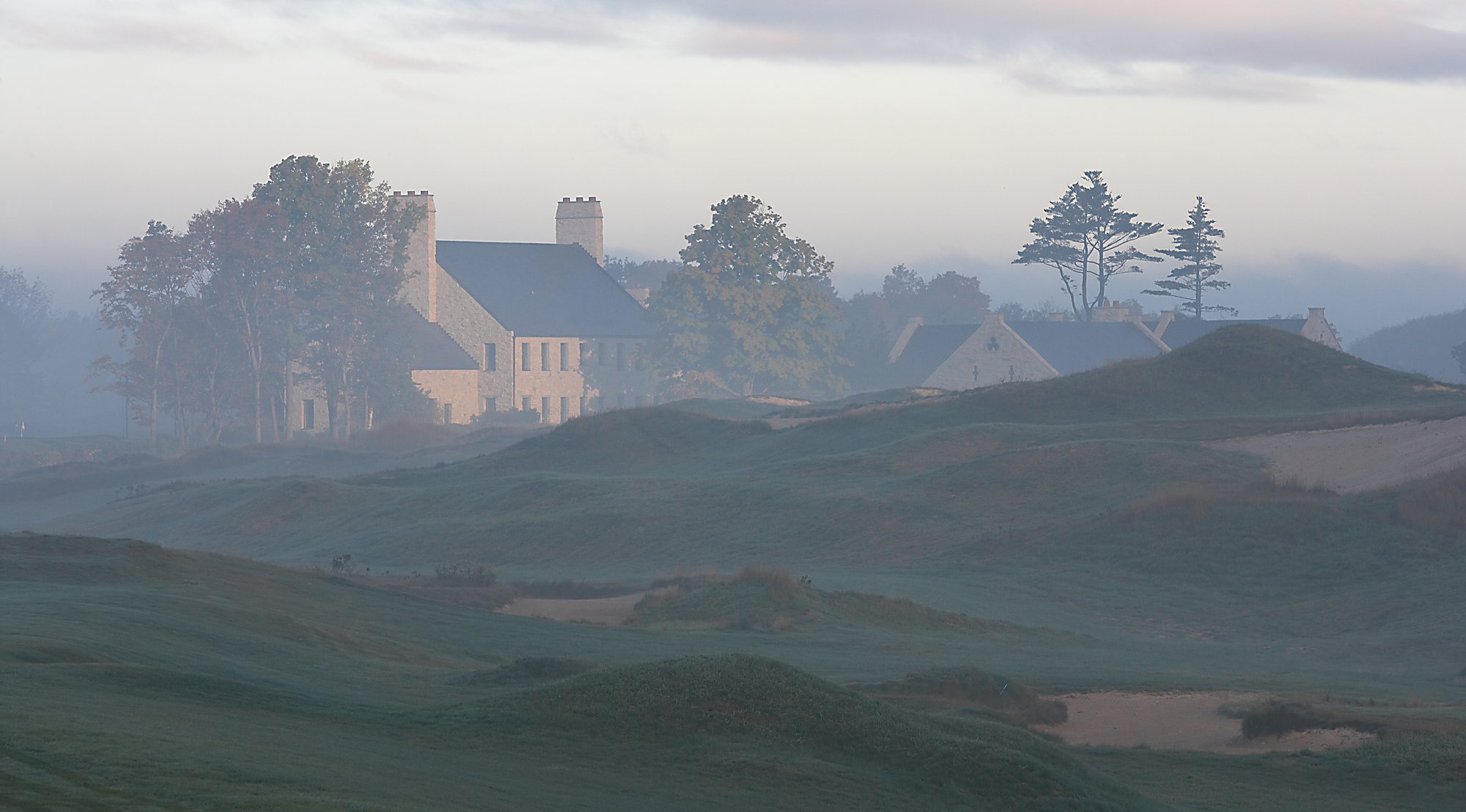
Whistling Straits Golf Course at Destination Kohler
Nothing
about Kohler, Wisconsin, is
unintentional.
It is the
expression of a remarkable vision unique to
America when planned
communities—sometimes characterized as
Utopian—sprang up in the 19th
century as places both autonomous and isolated
from the stewpot cultures of the
big cities.
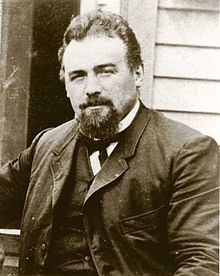 Many,
the
various Shaker and Amish communities, were wholly
based on religion and
philosophy. Others were founded on scientific and
social reform, like New
Harmony, Indiana’s Boatload of Knowledge. But
while there were certain elements of all
those in the establishment in 1873 of Kohler, its
founding was foremost a way
for Austrian immigrant John Michael Kohler (left) and
Charles Silberzahn to maximize
efficiency and costs for their booming Sheboygan
Union Iron and Steel Foundry,
which made their signature cast iron bathtubs and
farm implements and later
producing drinking fountains, plumbing fixtures,
engines, generators, and, of
course, the kitchen sink.
Many,
the
various Shaker and Amish communities, were wholly
based on religion and
philosophy. Others were founded on scientific and
social reform, like New
Harmony, Indiana’s Boatload of Knowledge. But
while there were certain elements of all
those in the establishment in 1873 of Kohler, its
founding was foremost a way
for Austrian immigrant John Michael Kohler (left) and
Charles Silberzahn to maximize
efficiency and costs for their booming Sheboygan
Union Iron and Steel Foundry,
which made their signature cast iron bathtubs and
farm implements and later
producing drinking fountains, plumbing fixtures,
engines, generators, and, of
course, the kitchen sink.
It was Kohler’s idea to have
his workers live within
a short distance of his new plant, set on 28 acres
of farmland, so a village was
developed and
incorporated in
1912. If not wholly Utopian, Kohler was truly a
company town, where Kohler’s son Walter contended
“A worker
deserves not only wages, but roses as well.” If not always a bed of roses
(workers have called four strikes
since 1934), the mostly immigrant workers paid
only $27.50 a month for room and
board to stay in a
marvel of Tudor
architecture named The American Club, opened in
1918, which included a pub,
bowling alley and barbershop. The management as
well provided lessons in the
English language and for gaining American
citizenship. Aesthetic standards for
homes were established, and a Residential Review
Board was established to
oversee any further development.
Around
the
Club the Olmsted Brothers, whose masterpiece of
landscaping had been NYC’s
Central Park, helped create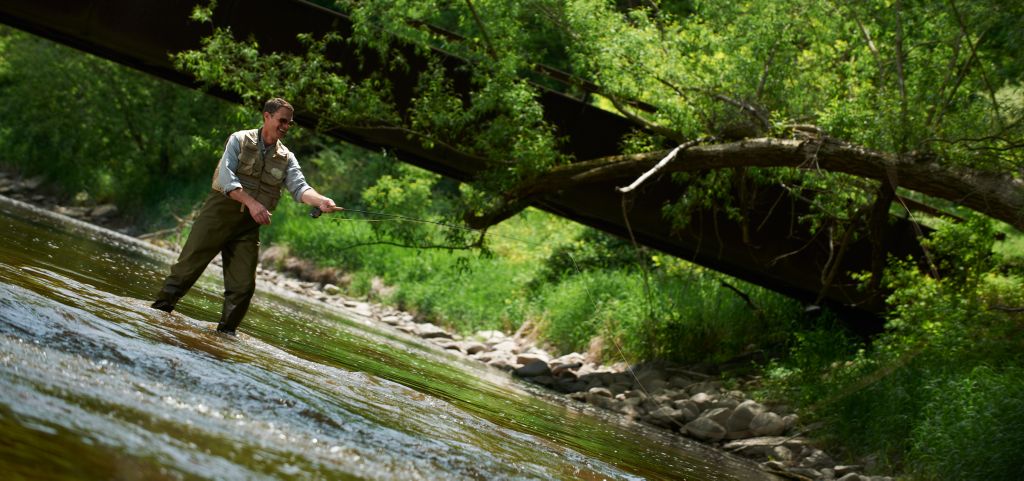 a 50-year master plan that would
take full
advantage of the natural beauty and quietude of
the woods and lake lands of
northeastern Wisconsin.
a 50-year master plan that would
take full
advantage of the natural beauty and quietude of
the woods and lake lands of
northeastern Wisconsin.
With an increase in families in
the town,
workers wanted their own homes, mostly to be built and sold at
cost by the company, so that
the American Club was eventually reconfigured as a grand inn, which was
placed on the National Register of
Historic Places in 1978.
I shall report next week
specifically about the
American Club, its various lodges, activities, and
restaurants, but let me
speak of the attractions that make Kohler itself a
beautiful and very special
place to visit.
My wife and I did
so in winter, which I do not highly recommend, for
the glory of the territory
bursts forth in spring, continues through a
brilliant summer and ends in a riot
of fall colors, from the yellow and red foliage to
the blue and silver shadings
of the sky and rivers, the gold of farmland and
the diverse greenery of
forests.
 As you can imagine in a land of lakes and
rivers, fall is an ideal time to fly fish the
Sheboygan River or Lake Michigan for
spawning king salmon and steelhead, or canoeing
and kayaking down the 25-mile
long river, though seven miles is the usual route
people take for a day trip.
Kohler’s River Wildlife offers upland and bird
hunting at three fields on different terrain, in
addition to trap
shooting. Of
course, merely hiking
or meandering at one’s leisure over the 500 acres
of the town’s land can be a
blessing in summer and fall for anyone who wants
to appreciate Wisconsin as
slowly as possible. (You’ll need snowshoes in
winter.) Horseback riding is also
available. As
you might imagine, golf is one of the principal
attractions
for visitors to the area, and the
Club has four courses, two each at Blackwolf Run
and Whistling Straits, designed
by Pete Dye. They have hosted three PGA
championships, the US Senior open and
two US women’s tournaments in 2012.
In 2020 the prestigious Ryder Cup Matches
will be held at Kohler.
As you can imagine in a land of lakes and
rivers, fall is an ideal time to fly fish the
Sheboygan River or Lake Michigan for
spawning king salmon and steelhead, or canoeing
and kayaking down the 25-mile
long river, though seven miles is the usual route
people take for a day trip.
Kohler’s River Wildlife offers upland and bird
hunting at three fields on different terrain, in
addition to trap
shooting. Of
course, merely hiking
or meandering at one’s leisure over the 500 acres
of the town’s land can be a
blessing in summer and fall for anyone who wants
to appreciate Wisconsin as
slowly as possible. (You’ll need snowshoes in
winter.) Horseback riding is also
available. As
you might imagine, golf is one of the principal
attractions
for visitors to the area, and the
Club has four courses, two each at Blackwolf Run
and Whistling Straits, designed
by Pete Dye. They have hosted three PGA
championships, the US Senior open and
two US women’s tournaments in 2012.
In 2020 the prestigious Ryder Cup Matches
will be held at Kohler.
Even in winter I found the Kohler Design Center to be among the
area’s most fascinating
attractions, since there is a Heritage Museum of
Kohler history—the brick
building of 36,000 square feet was transformed
from a recreation hall built for
the workers—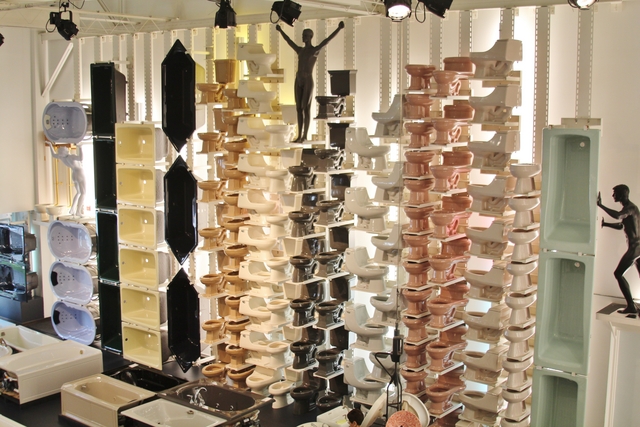 a
testament to American ingenuity and original
design as fine as
the Smithsonian’s Arts and Industries Building in
DC. Here
are the plows that broke the land,
the earliest tubs and stoves, massive generators
and diesel engines for the
war, and a cache of industrial graphics that are
priceless, along with a modern
art section whereby American artists pay homage to
industrial themes.
a
testament to American ingenuity and original
design as fine as
the Smithsonian’s Arts and Industries Building in
DC. Here
are the plows that broke the land,
the earliest tubs and stoves, massive generators
and diesel engines for the
war, and a cache of industrial graphics that are
priceless, along with a modern
art section whereby American artists pay homage to
industrial themes.
The Design Center itself is a
showcase for
contemporary Kohler bat and kitchen designs, not
least its “Great Wall of
China,” made from many colored toilets (right).
The
town has two shopping areas, one at
Woodlake and another at Deer Trace.
The former is
home to many
local designers and artists, like Art Imig’s men’s
clothing store, Kacia
women’s clothing, Wisconsin Trader home
furnishings, and Scentualities for
perfume and lingerie, as well as an Italian
restaurant named Cucina, Craverie
Chocolatier Café, and the ArtsSpace Gallery.
In nearby Sheboygan the
non-profit John
Michael Kohler Arts Center
emphasizes craft related forms and folkloric by
self-taught artists, all
located with Kohler’s restored mansion and the
former Mead Public Library.
NEXT WEEK: THE
AMERICAN CLUB
❖❖❖
By John Mariani
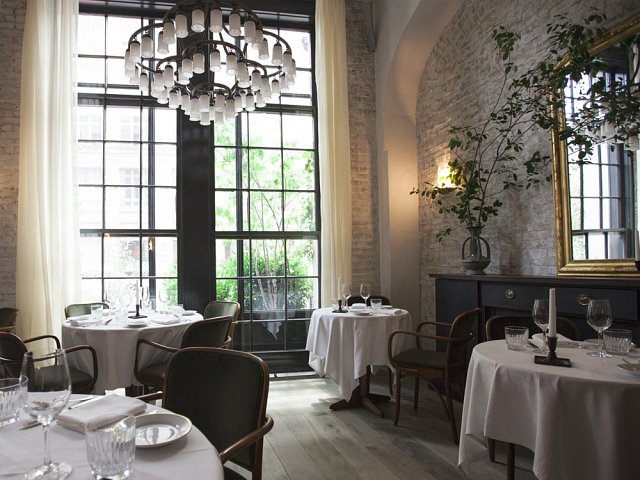
LE COU COU
138 Lafayette Street (near Canal Street)
212-271-4252
lecoucou.com
Here’s my prediction:
When Bon Appetit, Food and Wine, Esquire,
GQ and the rest of the
trend-frenzied magazines come out with their
best new restaurant lists for 2016, Le Coucou
will not be on any of them.
Apparently, owner Stephen Starr and chef
Daniel Rose did not get the memo that
no one any longer wants to eat at a beautiful,
softly lighted, civilized
restaurant with exquisitely crafted food, a
superbly selected wine list,
accepts reservations, and has a professional
staff taught to smile and say
“thank you” and 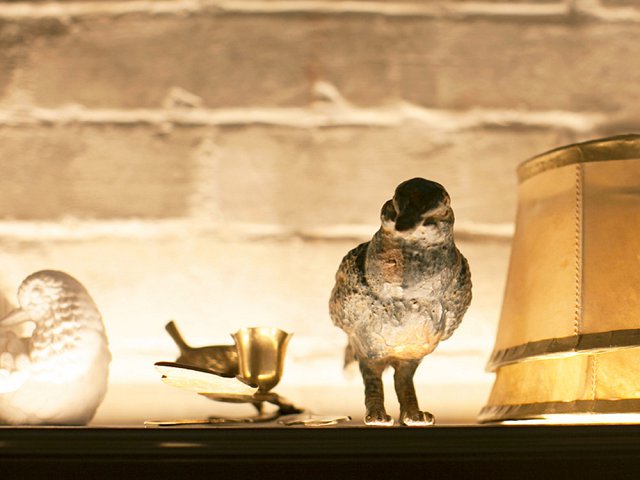 “hope you enjoyed
your meal” when you leave.
“hope you enjoyed
your meal” when you leave.
Le Coucou means “the cuckoo,”
which Starr might have churlishly
chosen to suggest an idea that’s a little crazy.
Fortunately,
NYC’s more inclusionary food critics, like Steve
Cuozzo of the Post
and Adam Platt of New York
magazine, have been in high
praise of Le Coucou, not least for its grown-up
approach to dining out. Let
me add my own fervid kudos.
At Le Coucou, Starr, who is
Philadelphia-based
and knows well the casual dining segment (El
Vez, Jones) as well as the big
house scene (Buddakan, Morimoto), has given NYC
his most ambitious fine dining
restaurant, while Chicago-born Rose, who has two
restaurants in Paris (La
Bourse et la Vie and Spring), has taken the leap
across the pond to show that
French cuisine still has its fans at a time when
the NYC restaurant scene teems
with hole-in-the-wall eateries winning multiple
stars for veggie burgers and
bowls of pho.
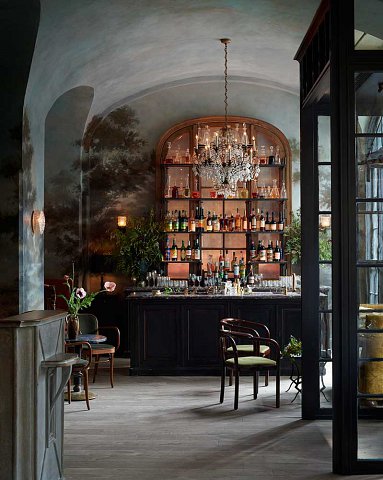 Despite
Le Coucou’s residence in a hotel innocuously
named 11 Howard (it
serves breakfast daily), the onus usually
attached to that situation
immediately evaporates when you enter this
80-seat dining room of such stunning
good taste, from the pewter chandeliers hung
from a high ceiling and heavy
curtains over triple-hung windows, to the swank
bar and the bright open
kitchen. The
rough brick walls are
off-white, the wooden floors bleached, the
chairs extremely comfortable, and
the white linen tablecloths have a soft heft. You’ll still find many
restaurants in France looking this
refined, but they are now rare in NYC, so you
may be forgiven if you allow
yourself the daydream of thinking you are in a
polished auberge in a city like
Chagny or Eugénie-les-Bains.
Despite
Le Coucou’s residence in a hotel innocuously
named 11 Howard (it
serves breakfast daily), the onus usually
attached to that situation
immediately evaporates when you enter this
80-seat dining room of such stunning
good taste, from the pewter chandeliers hung
from a high ceiling and heavy
curtains over triple-hung windows, to the swank
bar and the bright open
kitchen. The
rough brick walls are
off-white, the wooden floors bleached, the
chairs extremely comfortable, and
the white linen tablecloths have a soft heft. You’ll still find many
restaurants in France looking this
refined, but they are now rare in NYC, so you
may be forgiven if you allow
yourself the daydream of thinking you are in a
polished auberge in a city like
Chagny or Eugénie-les-Bains.
Some may no longer know
French cuisine when
they see it, but you will when you taste the
food at Le Coucou. Balance,
subtlety married to rich flavors, and a harmony
with wine, these are the
hallmarks of what Rose (below) has
devoted his career to following and producing. You
will not wince at a strange
concoction, never doubt that each dish has been
thoroughly thought through
rather than “created” on a whim, and you will
never have to guess what an
ingredient is.
The
menu has a judicious number of items that
the kitchen can turn out with great attention to
detail, though it’s printed in
somewhat confusing categories of hors
d’oeuvres and “gourmandises,”
then
“poissons
et viandes,” although
the gourmandises
function as small
main courses, and since everything is à la
carte, you can eat very well at a
good price.
Lobster is stuffed into
golden-green squash
blossoms with yogurt, mint, dill and cucumber
($21) that gives you your last taste
of summer, as does chicken and foie gras with
warm fruit ($25), while veal
tongue with golden ossietra caviar and crème
fraîche ($38) seems a precursor of
autumn. If you wish to know what they are
cooking in Paris these days, one bite
of Rose’s marvelous sweetbreads with tomato
cream and tarragon ($24) will tell
you, with great finesse. I
always seem to order quenelles of pike with a
Nantua sauce out of duty, but Rose’s, with a
similar lobster sauce Americaine
($26), was a revelation—the quenelle light as
helium, not at all spongy or
fishy, with a very delicate taste buoyed by an
unapologetically rich sauce of
tomato, white wine, brandy, plenty of butter and
a touch of cayenne in the
reduction of lobster meat and shells.
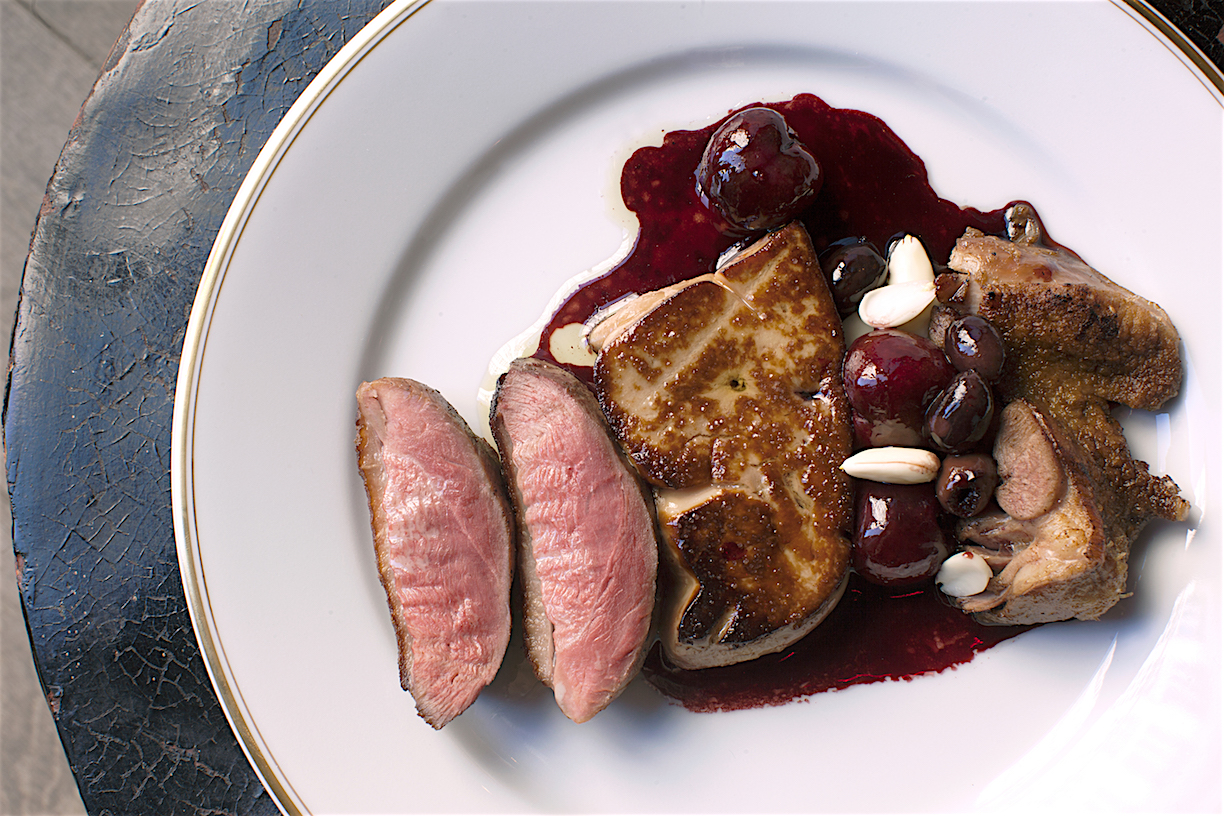 “Wagyu
tripe
with green tomato and olives” ($12) sounds like
a lily gilded, but in fact it’s
a crispy finger of tender American wagyu tripe,
gone in a few bland bites. The
only real—and
puzzling—disappointment was a bourride
of black bass and shellfish with aïoli
($38), because the fumé itself was
insipid.
“Wagyu
tripe
with green tomato and olives” ($12) sounds like
a lily gilded, but in fact it’s
a crispy finger of tender American wagyu tripe,
gone in a few bland bites. The
only real—and
puzzling—disappointment was a bourride
of black bass and shellfish with aïoli
($38), because the fumé itself was
insipid.
A dish called “Tour le lapin”
(all the rabbit)
includes renditions of meaty legs,
saddle
and liver treated to an herb-mustard basting and
pan juices enlivened by some
Manzanilla sherry. Very
juicy duck breast (left) comes
with sweet Mission figs, lustrous foie gras and
black olives ($38),
which is as Provençal-inspired a dish as you
will come by in NYC.
A must in any serious French
restaurant, a
selection of cheeses is offered 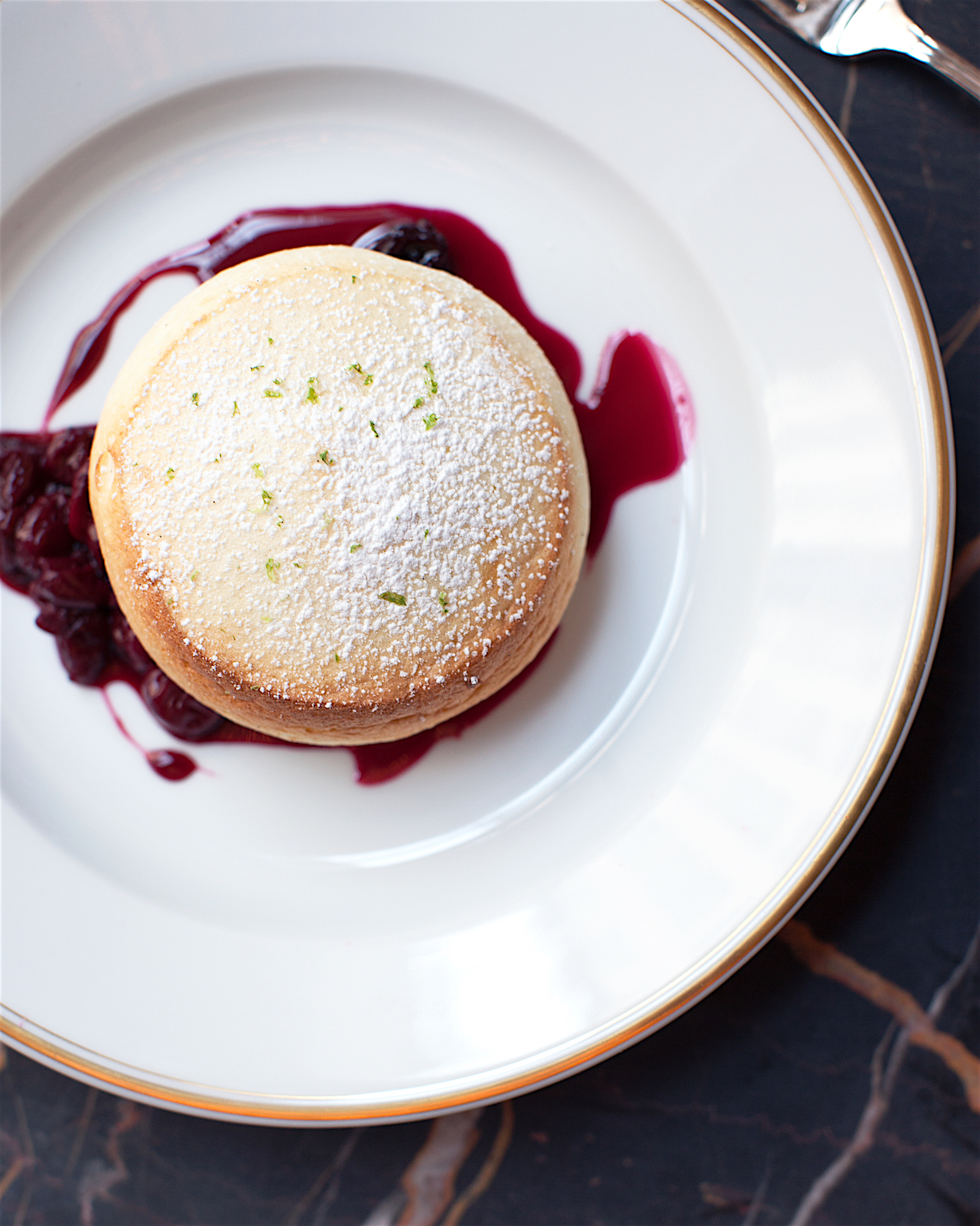 at Le
Coucou (one for $7, three for $21, five
for $35), and Daniel Skurnick’s desserts
maintain the same balance as the first
and second courses. A chiboust à
la
vanille (right)
with red wine cherries
($12), rice pudding with pistachios and
chartreuse ($11) and a pavé of
chocolate with gold leaf, glace
and pralines ($11) show delicate refinement and
complementary textures.
at Le
Coucou (one for $7, three for $21, five
for $35), and Daniel Skurnick’s desserts
maintain the same balance as the first
and second courses. A chiboust à
la
vanille (right)
with red wine cherries
($12), rice pudding with pistachios and
chartreuse ($11) and a pavé of
chocolate with gold leaf, glace
and pralines ($11) show delicate refinement and
complementary textures.
The 600-label wine
list, put together by Aaron Thorp, is largely
French, remarkable not just for
its breadth and depth but for the pricing, with
dozens of bottles under $70 in
every category and an amazing range of wines you
simply won’t easily find
anywhere else. But presenting it all in a
loose-leaf binder is pretty tacky.
That last small
detail stands out only because it does
stand out in a restaurant of such attention to
every detail, a trifle amidst an
array of impeccably thought-out style and
cuisine. For which reason most
people dress accordingly, despite the
restaurant allowing some ostensibly adult men to
sit down wearing t-shirts and
jeans.
In
almost every way,
then, Le Coucou is not a beacon but a testament
to the enduring appeal of an
evening where the management and the kitchen
want nothing more than to manifest
their own pleasure in having you as a guest.
Le Coucou is open daily for
breakfast,
lunch and dinner.
MAISON DROUHIN BRINGS ITS 2014
BURGUNDIES TO THE U.S MARKET
By John Mariani
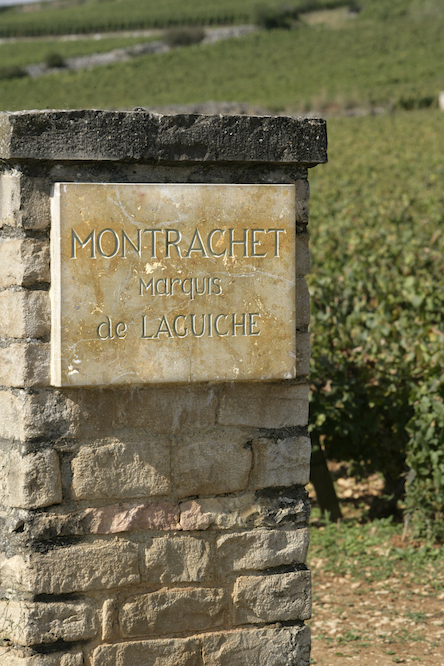 You
would think that after 136
years of making wine that a fourth-generation,
family-run domaine like Maison
Joseph Drouhin would have everything down pat. Yet President Philippe
Drouhin, CEO Frederic, enologist
Veronique and Director of the U.S. market
Laurent (right)
are, ironically, among the
avant-garde who have never rested on their laurels—and those laurels
have long
been among the most prestigious in Burgundy.
You
would think that after 136
years of making wine that a fourth-generation,
family-run domaine like Maison
Joseph Drouhin would have everything down pat. Yet President Philippe
Drouhin, CEO Frederic, enologist
Veronique and Director of the U.S. market
Laurent (right)
are, ironically, among the
avant-garde who have never rested on their laurels—and those laurels
have long
been among the most prestigious in Burgundy.
For some
time now Drouhin has
followed the principles of biological and
biodynamic cultivation on its 182.5
acres in order to limit the amount of chemicals
in the vineyards. It uses
natural predators to control spiders, compost
from organic matter instead of
fertilizers and allows certain vineyards to lie
fallow for a few years. It has also
switched to glass
 bottles that are ten percent
lighter, thereby reducing their carbon
footprint. And, not to be outflanked, the
company
has purchased 280 more acres in Oregon.
bottles that are ten percent
lighter, thereby reducing their carbon
footprint. And, not to be outflanked, the
company
has purchased 280 more acres in Oregon.
Like all
vignerons, the Drouhins
worry about vintages, sunshine, rainfall, and,
increasingly, climate change,
though Burgundy can always use more heat.
Production over the past five years
in Burgundy has been seriously down—as much as
40% in some vineyards. There are
concerns about what Brexit will mean to the
global market, and how overall
consumption of wine in Europe has dropped,
although more people are drinking
better wines.
Yet,
throughout it all, an estate
like Drouhin must maintain consistency at a time
when styles of wine change not
only due to climate but to popular taste.
"The Burgundian terroir expresses itself through
the vine: our role
is to translate and reveal its most subtle
messages,” reads the Drouhin
mantra. "Every effort is
made to respect this terroir in all its
diversity.”
That
consistency and commitment to
its motto of “Natural Elegance”
has always made the estate’s wines among the
most sought-after in France. In fact,
according to Laurent Drouhin
(who lives in a New York suburb), “only 25 cases
of our Musigny is allotted
this year to the United States. Only six
bottles—total—are allocated for all of
China.”
The 2014
vintage of Drouhin wines
are now coming into the U.S. market, and I had a
chance to taste many of them
at a lunch in NYC at Le Bernardin restaurant
with Laurent, who told me, “It’s
an excellent vintage, especially for the whites,
but a difficult year,
too.”
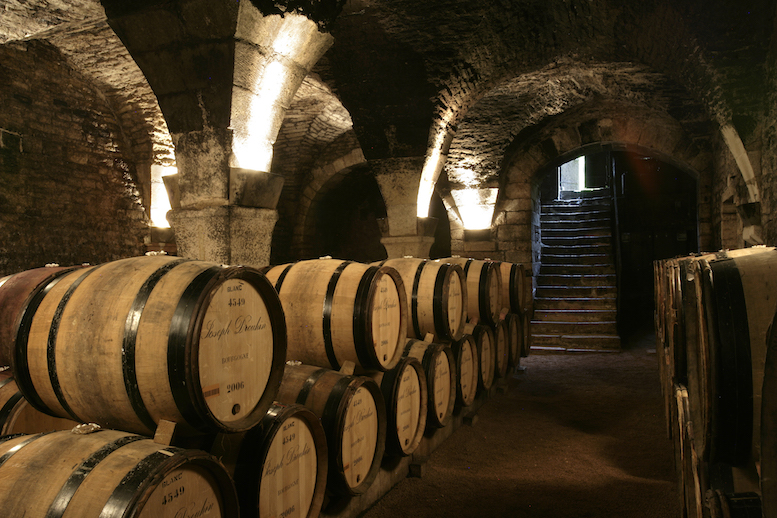 A report compiled by Laurent
with
Stephen Brook and Gerard Basset for Decanter
magazine, read: “The reds are less voluptuous
and rich than the 2009 or 2012
but also riper than the 2008.
There are many forward wines for drinking over
the next 8 to 10 years,
as well as superb wine from the top venues that
should age well in areas that
were affected by hail. We’re always presented
with challenges. First the yields
could be reasonably low. Second, levels of
extraction could be worrying high.
There’s a huge stylistic variation along the
Côte de Beaune wines. Many are limping,
others all dark and
dense.”
A report compiled by Laurent
with
Stephen Brook and Gerard Basset for Decanter
magazine, read: “The reds are less voluptuous
and rich than the 2009 or 2012
but also riper than the 2008.
There are many forward wines for drinking over
the next 8 to 10 years,
as well as superb wine from the top venues that
should age well in areas that
were affected by hail. We’re always presented
with challenges. First the yields
could be reasonably low. Second, levels of
extraction could be worrying high.
There’s a huge stylistic variation along the
Côte de Beaune wines. Many are limping,
others all dark and
dense.”
That’s
not a rave review of the
vintage, but, after tasting the Drouhin
examples, I again realized how those
136 years of experience count in keeping the
estate’s wines from any vintage at
a consistent level of quality.
The
Drouhin Vaudon
Chablis
Vaudesir is
proof that an
appellation wine made so widely—and often so
badly—in Burgundy can rise to
rival the more respected village whites of the
area, which almost justifies a
price of $80 by virtue of its depth and
complexity.
The Gevrey-Chambertin ($70), from
the slopes of the Côte de Nuits, is an excellent
wine, aged in oak for 15-18
months, powerful as Gevrey-Chambertin can be,
which makes it long-lived, though
I think this will be quite mature within the
next five years.
There are
two Puligny-Montrachets
in release: one, at $75, was
quite tangy and acidic; the other, the famous
Folatières
($115), was a finer wine,
better knit, toasty, grown high on the
slope in chalky soil that is reflected in the
wine’s minerality, which will
keep this a luscious wine for the next four
years.
Chassagne Montrachet
Morgeot
Marquis de Laguiche ($130) is a wine whose
acreage
is wholly controlled by Drouhin, rather than
parceled out to other owners or
negoçiants. If one had to choose a Burgundy that
shows the difference between a
French chardonnay and those of just about any
other country, this would be a
standard to judge by for its rich pear-like
flavors and just a hint of vanilla.
By the same token a
Côte de Beaune
Villages ($30) reminded me of a somewhat
funky California wine.
My
favorite wine of
the day was, not surprisingly,
Vosne
Romanée, which at $100 is worth every
penny. (It’s
a shame that in a restaurant this
would probably sell for more than two or three
times that price.) With an ideal
13% alcohol, it is elegantly structured and
balanced between fruit and tannins.
Drouhin owns just less than an acre of Vosne
Romanée turf, so it buys grapes
from growers in this tiny village in the Cotes de
Nuits. But the result is
magnificent, even in a troublesome vintage like
2014. Innovation
seems to count mist when experience
is solidly behind it.
MOST
FASCINATING OPENING SENTENCE OF THE MONTH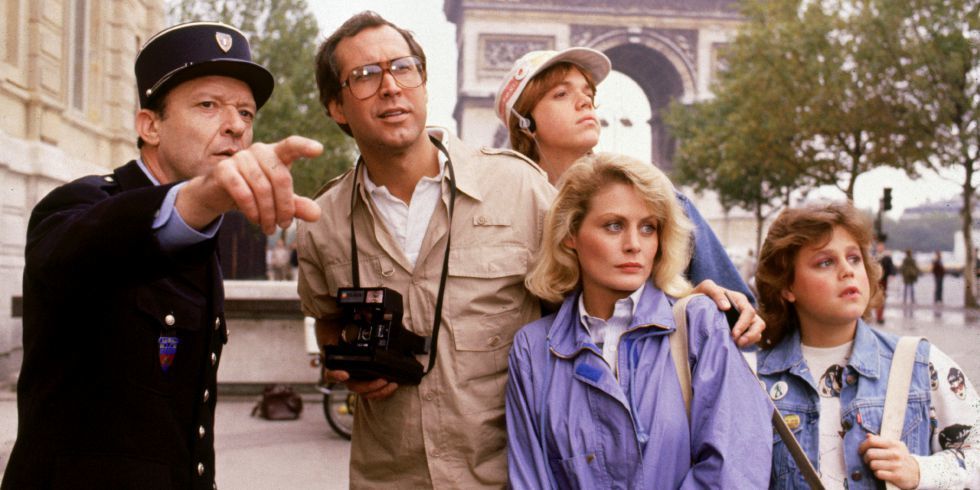
“This year we decided to
take our summer vacation in Amsterdam.”—Russell
Shorto, “Amsterdam, Revisited," NY Times
(9/4/16)

DO I GET FRIES VIT GROUND GLASS VIT DAT?
Burger King’s first St. Petersburg location is serving some limited-edition burgers that pay homage to performance artist Petr Pavlensky, who has nailed his testicles to the cobblestones of Red Square and cut off his earlobe. The new burgers include: One that’s been “partly sewn shut” to commemorate the time Pavlensky sewed his mouth shut (left) to protest the Kremlin’s jailing of Pussy Riot; a burger wrapped in “edible barbed wire” as an homage to the time Pavlensky stripped naked and got into a cocoon of barbed wire to protest repressive government policies; a burger “burnt on one side” to celebrate the time Pavlensky set the Federal Security Service’s door on fire.
Any of John Mariani's books below may be ordered from amazon.com.
 The
Hound in Heaven (21st Century Lion Books)
is a novella, and for anyone who loves dogs,
Christmas, romance, inspiration, even the supernatural, I
hope you'll find this to be a treasured favorite.
The story concerns how, after a New England teacher,
his wife and their two daughters adopt a stray puppy found
in their barn in northern Maine, their lives seem full of
promise. But when tragedy strikes, their wonderful dog
Lazarus and the spirit of Christmas are the only things
that may bring his master back from the edge of
despair.
The
Hound in Heaven (21st Century Lion Books)
is a novella, and for anyone who loves dogs,
Christmas, romance, inspiration, even the supernatural, I
hope you'll find this to be a treasured favorite.
The story concerns how, after a New England teacher,
his wife and their two daughters adopt a stray puppy found
in their barn in northern Maine, their lives seem full of
promise. But when tragedy strikes, their wonderful dog
Lazarus and the spirit of Christmas are the only things
that may bring his master back from the edge of
despair. WATCH THE VIDEO!
“What a huge surprise turn this story took! I was completely stunned! I truly enjoyed this book and its message.” – Actress Ali MacGraw
“He had me at Page One. The amount of heart, human insight, soul searching, and deft literary strength that John Mariani pours into this airtight novella is vertigo-inducing. Perhaps ‘wow’ would be the best comment.” – James Dalessandro, author of Bohemian Heart and 1906.
“John Mariani’s Hound in Heaven starts with a well-painted portrayal of an American family, along with the requisite dog. A surprise event flips the action of the novel and captures us for a voyage leading to a hopeful and heart-warming message. A page turning, one sitting read, it’s the perfect antidote for the winter and promotion of holiday celebration.” – Ann Pearlman, author of The Christmas Cookie Club and A Gift for my Sister.
“John Mariani’s concise, achingly beautiful novella pulls a literary rabbit out of a hat – a mash-up of the cosmic and the intimate, the tragic and the heart-warming – a Christmas tale for all ages, and all faiths. Read it to your children, read it to yourself… but read it. Early and often. Highly recommended.” – Jay Bonansinga, New York Times bestselling author of Pinkerton’s War, The Sinking of The Eastland, and The Walking Dead: The Road To Woodbury.
“Amazing things happen when you open your heart to an animal. The Hound in Heaven delivers a powerful story of healing that is forged in the spiritual relationship between a man and his best friend. The book brings a message of hope that can enrich our images of family, love, and loss.” – Dr. Barbara Royal, author of The Royal Treatment.
 |
The Encyclopedia of American Food and Drink by John F. Mariani (Bloomsbury USA, $35) Modesty forbids me to praise my own new book, but let me proudly say that it is an extensive revision of the 4th edition that appeared more than a decade ago, before locavores, molecular cuisine, modernist cuisine, the Food Network and so much more, now included. Word origins have been completely updated, as have per capita consumption and production stats. Most important, for the first time since publication in the 1980s, the book includes more than 100 biographies of Americans who have changed the way we cook, eat and drink -- from Fannie Farmer and Julia Child to Robert Mondavi and Thomas Keller. "This book is amazing! It has entries for everything from `abalone' to `zwieback,' plus more than 500 recipes for classic American dishes and drinks."--Devra First, The Boston Globe. "Much needed in any kitchen library."--Bon Appetit. |
"Eating Italian will never be the same after reading John Mariani's entertaining and savory gastronomical history of the cuisine of Italy and how it won over appetites worldwide. . . . This book is such a tasteful narrative that it will literally make you hungry for Italian food and arouse your appetite for gastronomical history."--Don Oldenburg, USA Today. "Italian
restaurants--some good, some glitzy--far
outnumber their French rivals. Many of
these establishments are zestfully described
in How Italian Food Conquered the World, an
entertaining and fact-filled chronicle by
food-and-wine correspondent John F.
Mariani."--Aram Bakshian Jr., Wall Street
Journal.
"Equal parts
history, sociology, gastronomy, and just
plain fun, How Italian Food Conquered the
World tells the captivating and delicious
story of the (let's face it) everybody's
favorite cuisine with clarity, verve and
more than one surprise."--Colman Andrews,
editorial director of The Daily
Meal.com. "A fantastic and fascinating
read, covering everything from the influence
of Venice's spice trade to the impact of
Italian immigrants in America and the
evolution of alta cucina. This book will
serve as a terrific resource to anyone
interested in the real story of Italian
food."--Mary Ann Esposito, host of PBS-TV's
Ciao
Italia. "John Mariani has written the
definitive history of how Italians won their
way into our hearts, minds, and
stomachs. It's a story of pleasure over
pomp and taste over technique."--Danny Meyer,
owner of NYC restaurants Union Square
Cafe, The Modern, and Maialino.
|
 |
 |
 |
 |
 |
 |
 |
 |
 Everett Potter's Travel Report:
Everett Potter's Travel Report: 
 Eating Las Vegas
JOHN CURTAS has been covering the Las Vegas
food and restaurant scene since 1995. He is
the co-author of EATING LAS VEGAS – The 50
Essential Restaurants (the fourth
edition of which will be published in early
2016), as well as the author of the Eating Las
Vegas web site: www.eatinglasvegas.
He can also be seen every Friday morning as
the “resident foodie” for Wake Up With the
Wagners on KSNV TV (NBC) Channel 3 in
Las Vegas.
Eating Las Vegas
JOHN CURTAS has been covering the Las Vegas
food and restaurant scene since 1995. He is
the co-author of EATING LAS VEGAS – The 50
Essential Restaurants (the fourth
edition of which will be published in early
2016), as well as the author of the Eating Las
Vegas web site: www.eatinglasvegas.
He can also be seen every Friday morning as
the “resident foodie” for Wake Up With the
Wagners on KSNV TV (NBC) Channel 3 in
Las Vegas.

MARIANI'S VIRTUAL GOURMET
NEWSLETTER is published weekly. Editor/Publisher: John
Mariani.
Editor: Walter Bagley. Contributing Writers: Christopher Mariani,
Robert Mariani, Misha
Mariani,
John A. Curtas, Edward Brivio, Mort Hochstein,
Andrew Chalk, Dotty Griffith and Brian Freedman. Contributing
Photographers: Galina Dargery, Bobby
Pirillo. Technical Advisor: Gerry McLoughlin.
To un-subscribe from this newsletter,click here.
© copyright John Mariani 2016

